How do you recognize a green woodpecker? How does his singing sound? And how do you distinguish male and female specimens? We answer these and other questions in our large green woodpecker profile.
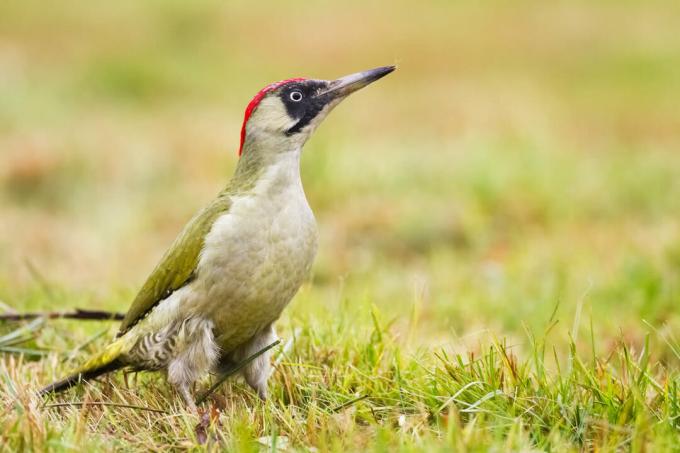
The Green Woodpecker (Picus viridis) is the second most common native woodpecker after the great spotted woodpecker. It is a regular sight in parks and gardens, where it likes to sit in the open ground or in the grass in search of its favorite food, the ants. Because of this peculiarity, the green woodpecker is also called ground woodpecker or grass woodpecker. If it hides in the dense undergrowth, its loud, laughing song can still be clearly heard in spring. The green woodpecker has a diverse habitat, which also includes meadow orchards. As a proxy for all the species that find a home on these valuable lands and to point out the threat and to draw attention to the increasing decline in this habitat, the green woodpecker was named "Bird of the Year 2014" chosen. You can find more interesting information on breeding events, appearance and support options in our large profile on the subject of green woodpeckers.
contents
- Description of the green woodpecker
-
identify green woodpeckers
- What does the green woodpecker song sound like?
- How do you recognize young green woodpeckers?
- How do the eggs look?
- How can you tell the difference between male and female green woodpeckers?
- Where does the ground woodpecker live?
- How and where do green woodpeckers build their nests?
- When do green woodpeckers breed?
- Where does the ground woodpecker winter?
-
How can you support the green woodpecker in the garden?
- What food do green woodpeckers prefer?
- Are nest boxes suitable for the green woodpecker?
- How can you give him additional support?
Description of the green woodpecker
| size | Approximately 31-33cm |
| Weight | About 180g |
| breeding season | April June |
| lifespan | Up to 10 years |
| habitat | Forests, meadow orchards, parks or gardens |
| feed preference | ants and their larvae |
| threats | Decline in food and natural habitat |
identify green woodpeckers
The green woodpecker lives up to its name. It is easily recognized by the moss green coloring of its back, wing and tail feathers. At over 30 centimetres, the ground woodpecker is also a fairly large bird, which is distinguished by its long, pointed beak, black facial mask and bright red crown. In flight, the green woodpecker can also be recognized by the typical wave-like flight of the woodpecker, the bright yellow lower back, also called rump, and the black, white-dotted wings.
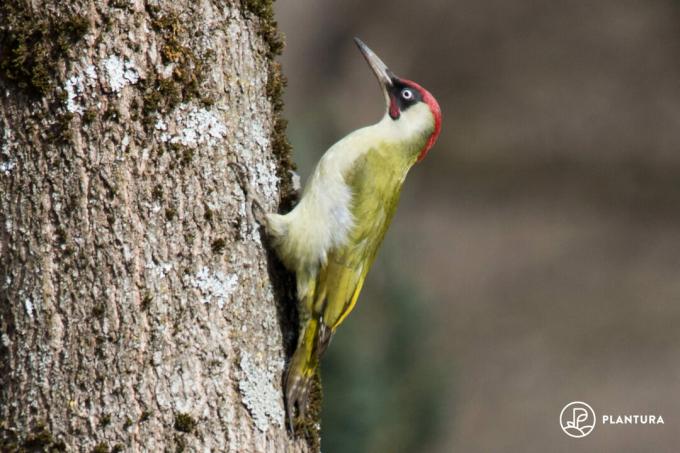
The green woodpecker can only be confused with the gray woodpecker, which has the same basic green color Compared to the green woodpecker, however, it is slightly smaller and has a gray head without a black face mask and red ones has crests.
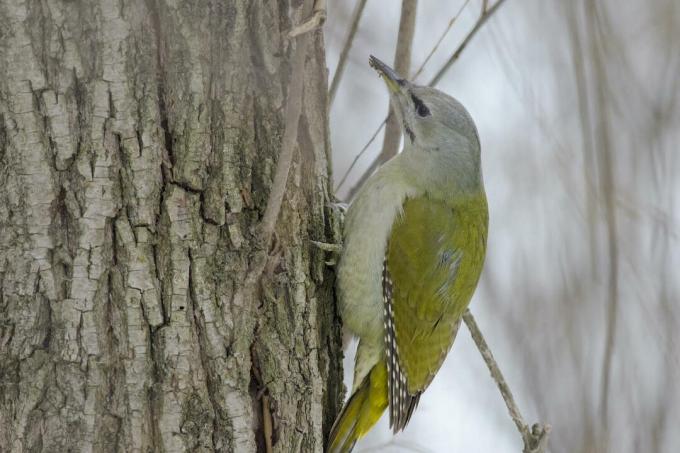
What does the green woodpecker song sound like?
In contrast to the great spotted woodpecker, the green woodpecker drums only very rarely because its beak is less powerful and not as well suited for such efforts. Instead, the woodpecker makes itself heard with a loud, laughing chant consisting of a long, gently falling stanza: "Ha-ha-ha-ha-ha-ha-ha-ha-ha-ha". This characteristic bird call has earned the green woodpecker the nickname "laughing bird". In addition to its laughing song, the green woodpecker has a call that it sometimes makes in flight or when excited. The green woodpecker's call consists of a quick, excited stanza: "By-b-b-b-b-b-b-b-b!"
You can listen to the song of the green woodpecker in this recording:

How do you recognize young green woodpeckers?
Young green woodpeckers are very easy to spot as they already look like small specimens of their parents. They only differ from the adult animals by the grey-spotted plumage on the face and abdomen, the lack of a black face mask and the somewhat blotchy red crown.

How do the eggs look?
Green woodpecker eggs measure about 31 x 23 millimeters and are bright white. The females lay between five and eight eggs per clutch in an existing or self-made tree cavity.
How can you tell the difference between male and female green woodpeckers?
Female and male green woodpeckers look the same at first glance. Only on closer inspection does one recognize the small but subtle difference: The beard stripe that extends from the rear edge of the When the beak pulls towards the nape of the neck, it is monochromatic black in the females - in contrast, it is bright red in the males filled in.

Where does the ground woodpecker live?
The habitat of the green woodpecker is very variable, but it prefers a somewhat open landscape. The green woodpecker is found in meadow orchards, in parks and large gardens. It also feels at home in deciduous or mixed forests, but there it tends to inhabit forest edges, clearings or other more open areas.
How and where do green woodpeckers build their nests?
Green woodpeckers like to use existing burrows made by other woodpeckers, as they have one less burrow than other species have powerful beaks better suited for foraging in soft wood and soil than for vigorous hammering is. If there is no such cave, the green woodpecker will still put his hand - or beak - into it himself. Then he prefers to use soft wood or trees that are already diseased to build his breeding cave. This work is mainly done by the males and can take up to three weeks. The brood cavity itself is about 50 centimeters deep at the end and has a slightly oval entrance hole measuring about six by seven centimetres.
When do green woodpeckers breed?
The female green woodpecker lays her eggs in April and then incubates them for about two weeks. After hatching, the young are dependent on their parents for 23 to 27 days before leaving the nest. Even then, their parents continue to look after them and help them find food for up to seven weeks. Green woodpeckers only brood a second time if the first offspring does not survive.
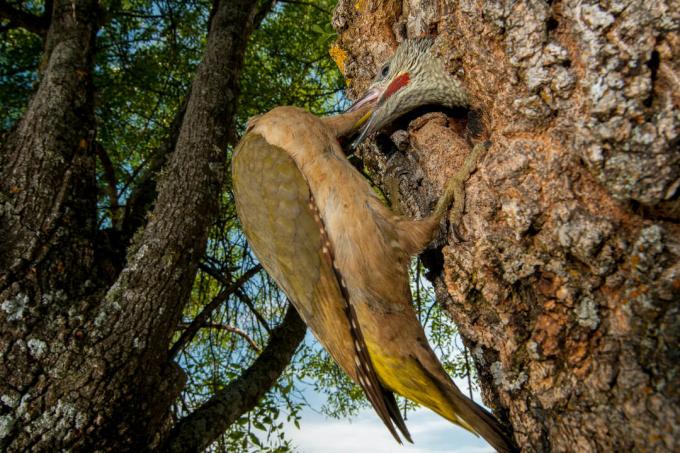
Where does the ground woodpecker winter?
Green woodpeckers are very sedentary birds. Even in winter they only leave their breeding area for a few kilometers and do not migrate south. Instead, they roam the cold landscape as loners, looking for food. Their favorite food source is ant nests. The green woodpeckers find these even under a thick blanket of snow.
How can you support the green woodpecker in the garden?
It is not uncommon for the green woodpecker to be observed in large gardens and parks. Due to the progressive loss of semi-open habitats such as meadow orchards or sparse mixed forests, the laughing bird is increasingly dependent on these secondary habitats. If you want to make it a little more comfortable for the native bird in your own garden, you will find some tips below on how you can support the green woodpecker.
What food do green woodpeckers prefer?
Green woodpeckers love ants. The small insects and their larvae are the main food of the pretty birds. Once they have located an ant nest, they often return there many times to satisfy their appetite and can be easily observed doing so. They use their beaks to dig holes in the ant hill and use their long, sticky tongues to pick up the small animals. Even in winter and under a thick blanket of snow, they can find these food sources again. When there is a shortage of ants, the green woodpeckers fall back on other insects that they pick from tree bark.

Are nest boxes suitable for the green woodpecker?
In theory, green woodpeckers are cavity nesters who like to take up existing cavities and could therefore actually be well supported with spacious full-cavity nest boxes. Unfortunately, however, in practice it has proved very difficult to develop nest boxes that will actually be accepted by green woodpeckers. Hanging up a nesting box for green woodpeckers is therefore a rather wasted effort. Here it makes more sense to focus on the species that you can actually support with nest boxes, such as blue tits, starlings or wrens.
How can you give him additional support?
You cannot support the green woodpecker in its breeding activities with nesting boxes. However, if you have the opportunity, you can provide natural nesting sites. For example, think carefully about whether a somewhat diseased or rotten tree really needs to be removed or whether it might serve as a breeding ground for a woodpecker.
The natural food supply can also be promoted by turning your garden into an insect and ant paradise. Even if ants are often not liked by people in the garden, the small animals are very important as food for many birds. In addition, the beneficial insects loosen up our soil and thus ensure a smooth material cycle. It is therefore worth thinking twice about using chemicals to drive ants out of the garden, which can also harm many other animals. On the other hand, if you want to go one step further and bring more life into your garden, you can do this with the help of our Plantura beneficial insect magnets succeed. In this way you can create a true paradise for small garden visitors, for which the green woodpeckers will also thank you.
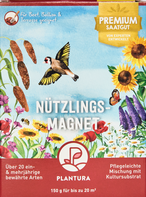
Plantura beneficial insect magnet
Annual & perennial species for beneficial insects
such as birds, bees & Co, easier to care for
Blossom dream in bed, pot & window box
Even more common than the green woodpecker is the great spotted woodpecker visiting our gardens. Take a look at his profile and learn more about native woodpeckers.
...and receive concentrated plant knowledge and inspiration directly in your e-mail inbox every Sunday!
